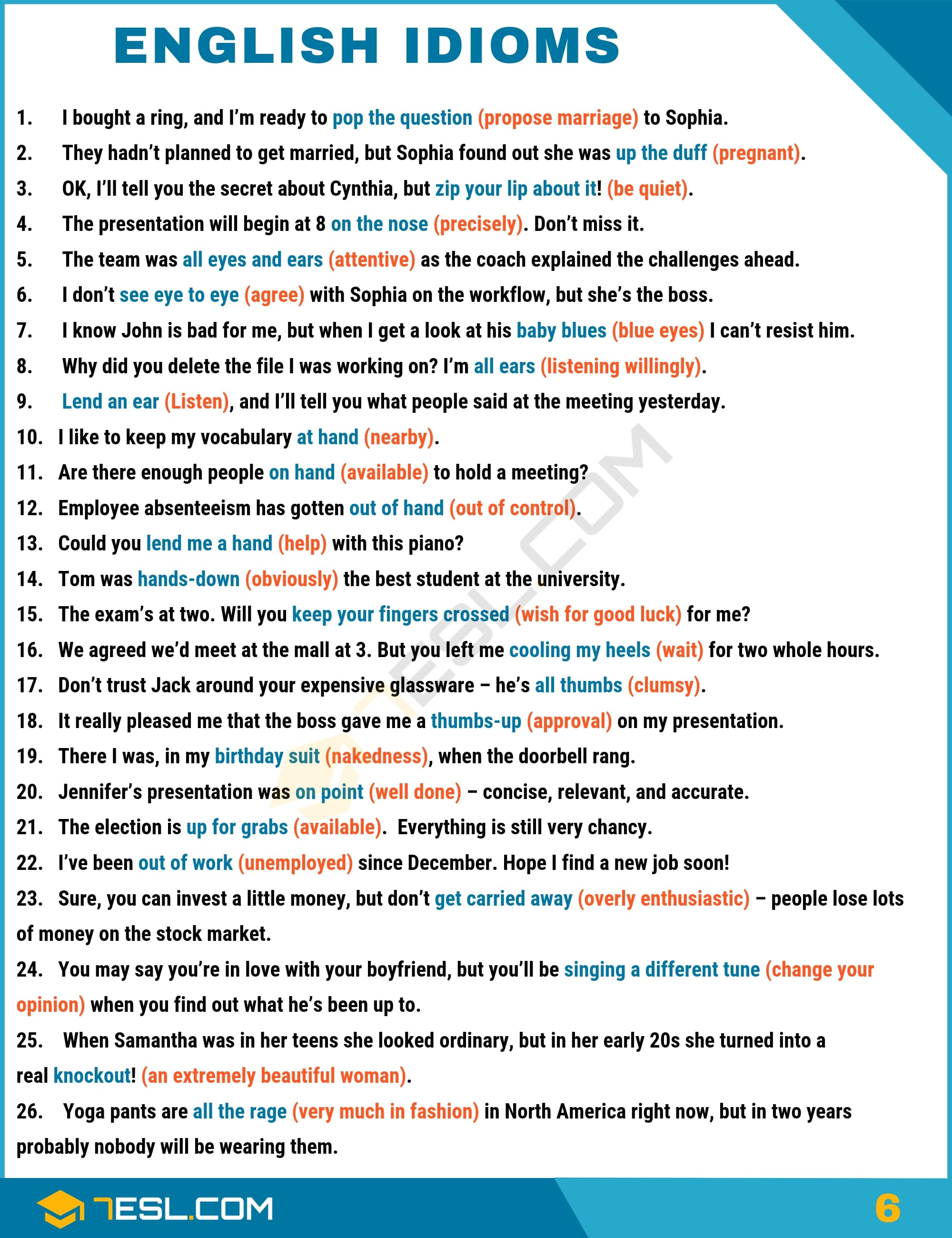Last Updated on November 20, 2023
If English isn’t your first language, or even if English is, idioms can be a little confusing. So often people fail to understand what exactly an idiom is, how to use it in everyday conversations, or how to spot or use them in writing. This guide should help you understand idioms more closely, and maybe give you some ideas about how to start using them yourself. So, what is an idiom?
What Are Idioms?
Figurative and Literal Meanings
Idioms are common phrases or expressions in a language that has a figurative meaning rather than a literal one. In other words, the meaning of an idiom cannot be deduced by looking at the individual words in the phrase. For example, the idiom “kill two birds with one stone” means to accomplish two tasks at once, and its meaning cannot be gleaned from the literal interpretation of the words.
English language learners often find idioms challenging because the figurative meaning is not always apparent. Familiarity with idioms is crucial for understanding the nuances of English and communicating effectively.
Some common English idioms and their figurative meanings include:
- “Break a leg”: Good luck
- “Bite the bullet”: Face a difficult situation bravely
- “Hit the nail on the head”: To be exactly right
Importance in Language Learning
Learning idioms is vital for anyone seeking to understand and speak English fluently. They are pervasive in everyday conversations, literature, and popular culture. Knowing idioms can not only facilitate communication but also help learners appreciate the richness of the language.
Here are some tips for learning English idioms:
- Context: Observe idioms used in context, like in books, movies, or conversations. This can help to grasp the meaning and usage better.
- Practice: Incorporate idioms into daily conversations and writing to become more comfortable with their usage.
- Grouping: Organize idioms into categories, such as food-related or animal-themed idioms. This can make it easier to remember them.
- Keep it natural: Avoid forcing idioms into conversations. Instead, use them when they fit the situation naturally.
By gaining an understanding of idioms and their meanings, learners of English can improve their communication skills and ensure that they convey their thoughts more effectively. Additionally, mastering idioms can help language learners appreciate the cultural richness and linguistic variety of the English language.
Learn more about English proverbs – common sayings from which we can learn something.
Common English Idioms
English idioms are expressions or phrases that have a figurative meaning, different from their literal meaning. They enhance the language by adding color and depth to communication. This section will explore some common idioms in English related to animals, food, and prepositions.
Animal Idioms
Animal idioms are quite prevalent in the English language. These idiomatic expressions use animals as symbols to convey a specific meaning or concept. Here are a few examples:
- A cat nap: a short sleep
- Let the cat out of the bag: to reveal a secret
- A fish out of water: someone who is out of their usual environment or in an uncomfortable situation
- The early bird catches the worm: arriving early or starting something ahead of time can lead to success
- Raining cats and dogs: raining heavily
Food Idioms
Food idioms are also a popular subset of English idiomatic expressions. They often use food items or the act of eating as metaphors to describe various situations. Some examples include:
- Food for thought: something that makes you think or that requires careful consideration
- A piece of cake: an easy task
- Break the ice: to make a tense or awkward situation more relaxed by initiating conversation
- Cry over spilled milk: to be upset over something that has already happened and cannot be changed
- Bite off more than you can chew: to take on a task that is too big or difficult
Preposition Idioms
Preposition idioms feature common prepositions, such as “in,” “on,” “up,” and “out.” These expressions can be quite versatile and are often used in everyday conversation. Some examples are:
- Up in the air: uncertain or undecided
- On the fence: undecided or not taking a side in a decision
- In hot water: in trouble or facing difficulties
- Out of the blue: unexpectedly or without warning
- Once in a blue moon: very rarely or infrequently
Mastering common idioms in English provides a more comprehensive understanding of the language and can enhance one’s conversation skills. This understanding can be particularly helpful when interacting with native speakers or engaging in various social and professional settings.
Idiom Examples and Meanings
Popular Idioms
- A piece of cake: This expression means that something is easy to do. For example, “The math test was a piece of cake for her because she studied a lot.”
- Hit the sack: This idiom implies that someone is going to bed or sleep. For instance, “I’m exhausted; I’m going to hit the sack.”
- Every cloud has a silver lining: This phrase reminds us that even in difficult situations, there is often something positive to be found. Example: “Although she lost her job, she found a new one with a higher salary; every cloud has a silver lining.”
- On cloud nine: This idiom means feeling extremely happy or joyful. An example usage could be, “When he won the lottery, he was on cloud nine.”
Less Common Idioms
- Lose your marbles: This expression implies that someone is acting crazy or illogical. For instance, “My neighbor started building a UFO in his backyard. I think he’s lost his marbles.”
- When pigs fly: This phrase is used to highlight the impossibility of a situation or event occurring. An example would be, “He said he’d clean his room without being asked? Yeah, when pigs fly!”
- Snug as a bug in a rug: This idiom describes someone or something that is very cozy and comfortable. For example, “She was curled up on the couch under a warm blanket, snug as a bug in a rug.”
In this section, we covered examples and meanings of popular idioms such as “a piece of cake,” “hit the sack,” “every cloud has a silver lining,” and “on cloud nine.” We also discussed less common idioms like “lose your marbles,” “when pigs fly,” and “snug as a bug in a rug.” These idioms and expressions add color and depth to the English language, making it more enjoyable for both native speakers and learners alike.
Idiomatic Expression Origins
Historical Origins
Idioms are expressions that have a figurative meaning, separate from the literal meaning of the words they contain. These phrases often have historical origins, rooted in a particular culture, time period, or event. For instance, “raining cats and dogs” as an idiom for heavy rain possibly originates from old English days when animals of all kinds could be found on the straw roofs. During heavy rain, the wet straw roofs became slippery and animals might fall from them, making people believe it was raining cats and dogs.
Another example: the phrase “bite the bullet” means to face a difficult situation with courage. This idiom is believed to have emerged during the time of warfare when wounded soldiers would bite on a bullet while undergoing surgery to endure the pain.
Most idioms have an extensive history of being used over an extended period of time. Many have origins in the Bible and even more are derived from Old English or Latin phrases and words. Well-known authors like Shakespeare, Chaucer, and many others have used or are solely responsible for the creation of some idioms in their works of poetry, drama, plays, and more. These well-known authors used idioms to prevent their writing from sounding bland, mundane, and repetitive by using the same old boring comparisons using both relative and literal terms. In fact, most of the popular idioms that we still use to this very day have stood the ultimate test of time having originated thousands of years ago.
Cultural Origins
Many idioms take their meanings from the cultural practices, beliefs, or values of a specific group. For example, “break a leg” is an expression used to wish someone good luck, especially in the performing arts. This phrase possibly originates from the superstition that wishing someone “good luck” would bring them the opposite. Therefore, instead of saying “good luck,” actors would be told to “break a leg” to avoid attracting bad luck.
Another example is “grab the bull by the horns,” which means to tackle a problem or challenge head-on. This idiom is believed to have originated from the tradition of bullfighting, where a bullfighter would assert control by grabbing a bull’s horns.
Overall, idiomatic expressions often have historical and cultural origins that can provide fascinating insights into the context in which they were first used. Proverbs and sayings provide a rich tapestry of meanings and connections that can help us understand the world around us and enrich our language skills.
Challenges in Learning Idioms
Native vs. Non-Native Speakers
Learning idioms in any language can be a complex and multi-faceted task. For native speakers, idioms are a natural part of their linguistic repertoire, as they are learned and internalized through exposure and context. Non-native speakers, however, often face difficulties when trying to learn and use idioms effectively.
For non-native speakers, learning idioms can be especially challenging due to their unpredictable nature. The meaning of idioms often does not match their literal translations, which can lead to confusion and miscommunication. Non-native speakers must not only learn the idiomatic expression itself but also understand the cultural and situational contexts in which it is used.
It may also be more difficult for non-native speakers to remember idioms and their meanings, as idioms typically do not follow a recognizable pattern or structure. This means that learners must memorize each idiom independently, rather than relying on a formula or pattern to support their memory.
Idiomatic vs. Literal Translation
When learning idioms in English or any other language, a key challenge for learners is distinguishing between idiomatic and literal translations. Idiomatic translations convey the intended meaning of an idiom in a clear and contextually appropriate way. Literal translations, on the other hand, may lead to confusion, as they often do not capture the intended meaning of the idiomatic expression. Thus, understanding the difference between idiomatic and literal translations is crucial for effective language learning.
To help with this distinction, language learners can:
- Look for clues in the surrounding context to help determine whether an expression is being used idiomatically or literally.
- Practice exposure to idiomatic language by engaging with native speakers, consuming authentic material like movies, books, and podcasts, and attending language courses focused on idiomatic expressions.
- Utilize language resources such as dictionaries and online tools designed specifically for idiomatic language learning.
In conclusion, learning idioms poses various challenges for both native and non-native speakers, particularly in terms of distinguishing between idiomatic and literal translations. Addressing these challenges requires dedication, practice, and exposure to authentic contexts to develop a rich understanding of idiomatic language.
Using Idioms Effectively
Context and Tone
When using idioms in English, it is essential to consider the context and the tone of voice. An idiom can serve as an artistic expression, helping to convey complex ideas or emotions more creatively. However, to be an effective and fluent English speaker, one must appropriately match idioms with the situation and the desired tone.
For instance, using idiomatic expressions in casual conversation with friends can add color and humor, creating a relaxed atmosphere. In contrast, employing idioms in formal contexts, such as business meetings or academic papers, may not always be suitable. It’s crucial to understand your audience’s expectations and familiarity with idioms, as using them effectively builds trust and credibility.
Avoiding Overuse
While idioms can be a powerful tool for communication, it is essential to avoid overusing them to prevent your message from becoming cluttered or confusing. Striking a balance between idiomatic and literal language is key. Here are some tips to help you:
- Use idioms sparingly: Restrict yourself to one or two idioms in a conversation or a piece of writing to prevent your message from becoming overly ambiguous.
- Focus on clarity: Ensure the main point of your message remains clear and comprehensible, even when using idiomatic expressions.
- Be aware of cultural differences: Idioms are often specific to a particular culture or region, so when speaking to or writing for an international audience, make sure the idioms you choose are universally understood or provide explanations as needed.
In summary, using idioms effectively in English requires considering the context, tone of voice, and avoiding overuse. By following these guidelines, you can enhance your communication and establish yourself as a talented and fluent English speaker.
English Idioms | Images
We use idioms daily for several reasons. When used as either a part of a conversation or as a part of writing, idioms have a way of making what we are attempting to say better. Idiomatic phrases add color and poetry to what we say and what we write. They also give us a way to make the people on the other end listening think outside the box due to their figurative language. It makes people stop and think “what did they mean by that?” Some idioms even invoke laughter from the listener or reader by making them picture something that seems highly unlikely. Finally, the usage of idioms makes great comparisons and these unlikely comparisons can impress readers and listeners of our work alike.
Idiom Videos
FAQs on Idioms
What is an idiom?
An idiom is a figurative expression or phrase that, when considered as a whole, conveys a meaning different from the individual meanings of its component words. These phrases are unique to a specific language and often reflect the culture, history, and experiences of its speakers.
How do idioms work?
Idioms function based on a language’s syntax, which is the arrangement of words and phrases. Their meanings can vary depending on factors such as the region of a country or the context in which they are used.
Why are idioms difficult for language learners?
Because idioms have meanings that are not directly deducible from their individual words, they can be challenging for people learning a new language. Additionally, idiomatic expressions often involve cultural elements that may not be familiar to learners, which can make them even more confusing.
What are some common examples of idioms in English?
- “Break a leg” – means to wish someone good luck, often before a performance
- “Bite the bullet” – to endure a painful or difficult situation
- “Raining cats and dogs” – raining very heavily
- “The ball is in your court” – it is your responsibility or the decision is yours
How can I learn and practice idioms?
There are several ways to learn idioms, such as:
- Studying lists of common idioms with their meanings and example sentences
- Reading books, articles, or watching movies/TV shows in English to see idioms used in context
- Practicing using idiomatic expressions in conversation with native speakers or in language learning groups
Are idioms used in formal writing?
Generally, idioms are more commonly found in informal contexts, such as conversations and casual writing. They are less frequently used in formal writing, as they can introduce ambiguity or be perceived as too colloquial. However, some idioms are widely accepted and may be appropriate in specific scenarios, depending on the desired tone and audience.
Idioms Dictionary
Idioms (Categories)
Idioms (A-Z)
- Hypocritical Meaning: What Does This Term Mean? - January 27, 2024
- SWAG Meaning: What Does it Mean? - January 25, 2024
- Hypocrisy Meaning: What Does it Mean? - January 20, 2024









Iam willing and grade to learn the idioms, they helped me so much.
This is helpful ad I am on cloud nine to study on this website. Thanks
I am greatfull God bless everyone of us as we are ready to learn
bruh i hack
Am hello
it is help full to us
it is thank full to me or us